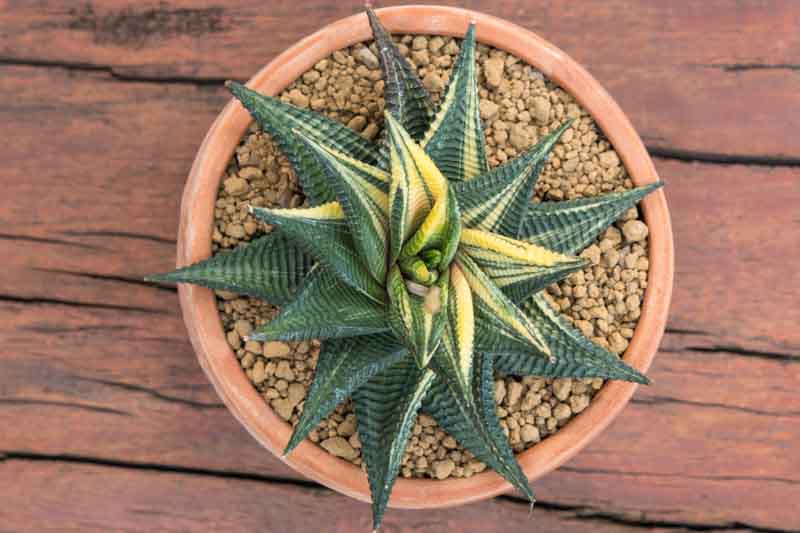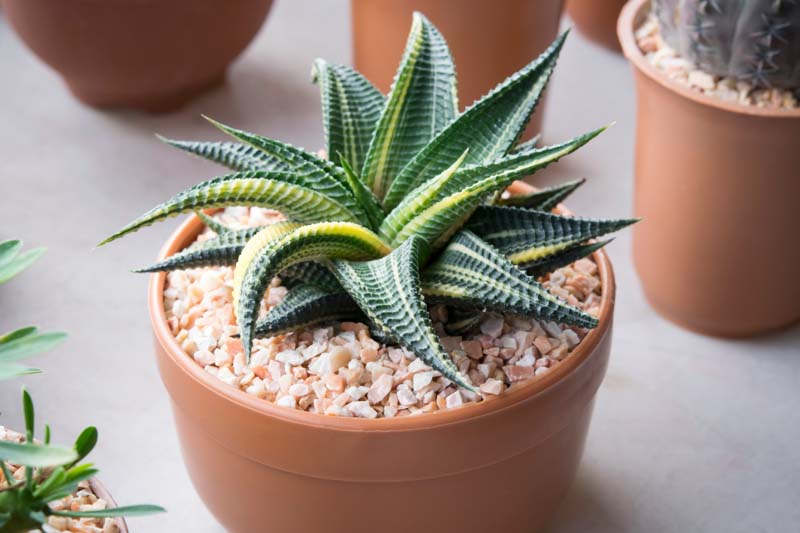Variegated Fairy Washboard, Haworthia limifolia 'Variegata'
Haworthiopsis limifolia ‘Variegata’, a striking variant of the well-loved Fairy Washboard, boasts all the resilient and ornamental qualities of its green counterpart but with the added allure of variegated leaves. This succulent is a favorite among collectors for its unique appearance and ease of care.
Haworthiopsis limifolia ‘Variegata’ is characterized by its rosettes of thick, triangular leaves that are adorned with distinctive horizontal ridges. What sets the variegated form apart are the streaks or margins of creamy white or yellow that contrast beautifully against the dark green foliage, enhancing the texture provided by the ridges.
Native: Haworthiopsis limifolia is native to the eastern regions of South Africa, where it thrives in partial shade under the protection of shrubs or rocks. Its native habitat has equipped it to be both hardy and adaptable, capable of thriving in various environments. Haworthiopsis limifolia belongs to the Asphodelaceae family along with Aloe, Eremurus (Foxtail Lily), and Hemerocallis (Daylily).
Plant Type and Habit: As a perennial succulent, Haworthiopsis limifolia ‘Variegata’ forms dense rosettes that can eventually produce offsets and form clumps. This slow-growing plant maintains a compact size, making it an ideal choice for indoor cultivation.
Size: The plant generally reaches about 4 to 6 inches (10 to 15 cm) in height and diameter. Its growth is mostly vertical, with the leaves stacking tightly to form the rosette.
Flowers: It blooms in late spring to early summer with slender, tubular green and white flowers that appear on a long, thin inflorescence extending from the rosette. The flowers are small but add a delicate contrast to the robust foliage.
Foliage: The foliage is the main attraction, with each leaf featuring pronounced horizontal ridges and striking variegation. The contrast between the creamy white or yellow margins and the dark green leaves creates a visually appealing texture and color palette.
Hardiness: This succulent is hardy in USDA zones 10a to 11b. It can tolerate temperatures as low as 30°F (-1°C) for short periods, but it thrives best in warmer conditions and should be protected from frost.
Uses: This succulent is primarily used as an ornamental plant. It’s perfect for terrariums, indoor container gardens, rock gardens, and as a desk plant. Its compact size and unique appearance make it a popular choice for adding a touch of nature to small spaces.
Toxicity: Haworthiopsis limifolia is generally considered non-toxic to pets and humans, making it a safe choice for households with animals.
Drought: Like most succulents, Haworthiopsis limifolia is highly drought-tolerant once established, requiring minimal watering.
Invasiveness: This plant is not invasive and is well-contained within its growing area, making it a responsible choice for gardens and indoor settings.
Benefits: Its water-wise nature aligns with eco-friendly gardening practices, and its ease of care makes it a fantastic plant for beginners.

Growing and caring for Haworthiopsis limifolia, both indoors and outdoors, requires attention to a few specific conditions to ensure its thriving growth and the maintenance of its distinctive striped leaves.
Light: Haworthiopsis limifolia flourishes in bright, indirect light. Place it near a window that receives ample light throughout the day, but avoid direct sunlight, which can scorch the leaves. A north or east-facing window is ideal.
Water: Water sparingly, allowing the soil to completely dry out between waterings. During the winter months, reduce watering frequency, as the plant enters a dormant period.
Soil: Use a well-draining cactus or succulent mix to prevent root rot. Adding perlite or pumice can enhance drainage.
Temperature: Maintain indoor temperatures between 60°F and 80°F (15°C and 27°C). Avoid exposing the plant to temperatures below 50°F (10°C), as cold can damage it.
Humidity: Haworthiopsis limifolia tolerates average indoor humidity levels well. No special adjustments are necessary.
Feeding: Fertilize lightly with a diluted succulent fertilizer during the growing season (spring and summer), once in spring and once in summer.
Repotting: Repot every 2 to 3 years or when the plant outgrows its pot. This is also a good opportunity to separate and pot any offsets.
Hardiness Zone: This succulent is best suited for outdoor growth in USDA hardiness zones 10a to 11b, where temperatures rarely drop below freezing.
Light: In the garden, choose a location that offers partial shade or filtered sunlight to mimic its natural habitat under shrubs or rocks.
Soil: Ensure the outdoor planting site has excellent drainage. Amend garden soil with sand or gravel if necessary to improve drainage.
Water: Outdoor plants may require more frequent watering than indoor ones, especially during hot, dry periods. However, it’s still important to let the soil dry out between waterings.
Protection: In regions with cold winters, consider growing Haworthiopsis limifolia in containers that can be moved indoors or provide adequate frost protection if planted in the ground.

Propagating Haworthiopsis reinwardtii is straightforward and can be done through offsets.
Wait for Offsets: Haworthiopsis reinwardtii produces small offsets or pups around the base of the mother plant. For a higher success rate, wait until these pups are a reasonable size (at least an inch wide) before separating them.
Separate Offsets: Carefully remove the soil around the base of the mother plant to expose the offsets. Using a clean, sharp knife or scissors, cut the offsets away from the parent plant, ensuring each has some roots attached.
Let Offsets Dry: Place the offsets in a warm, dry location out of direct sunlight for a few days to allow the cut surfaces to callous over. This helps prevent rot when planted.
Plant Offsets: Plant the calloused offsets in a well-draining succulent soil mix. Use small pots with drainage holes to prevent water retention.
Water Sparingly: Water the newly potted offsets lightly to encourage root growth. Wait until the soil is completely dry before watering again.
Haworthiopsis limifolia is generally easy to care for, but like all plants, it can encounter pests, diseases, and common problems.
Spider mites: Tiny spider mites can cause yellowing leaves and fine webs on the plant. Increase humidity around your Haworthia and spray with water or neem oil to control them.
Mealybugs: These small, white, cottony pests can hide in the crevices of the plant, sucking sap and weakening it. Treat by dabbing the bugs with a cotton swab dipped in alcohol or applying an insecticidal soap.
Aphids: Though less common, aphids can also affect Haworthias, feeding on the sap and causing growth issues. Rinse the plant with a strong water stream or use insecticidal soap to remove them.
Root rot: Overwatering is the primary cause of root rot in Haworthias, leading to black, mushy roots and base. Prevent this by allowing the soil to dry out completely between waterings and ensuring good drainage.
Fungal Diseases: Fungal infections can occur in overly humid conditions or when leaves are kept wet. Reduce humidity around the plant and water from the bottom to avoid wetting the leaves.
Etiolation (Stretching): Insufficient light can cause Haworthias to stretch out, losing their compact shape. Provide brighter, indirect light to encourage more compact growth.
Sunburn: Direct, intense sunlight can scorch the leaves, leaving brown marks. Gradually acclimate plants to brighter conditions or provide filtered sunlight.
Watering Issues: Both overwatering and underwatering can cause problems. Overwatering leads to root rot, while underwatering may cause the leaves to become thin and wrinkled. Adjust your watering schedule according to the season and the plant’s needs.
| Hardiness |
10 - 11 |
|---|---|
| Heat Zones |
10 - 12 |
| Climate Zones | 15, 16, 17, 20, 21, 22, 23, 24 |
| Plant Type | Houseplants, Cactus & Succulents |
| Plant Family | Asphodelaceae |
| Genus | Haworthia |
| Exposure | Full Sun, Partial Sun |
| Season of Interest |
Spring (Early, Mid, Late) Summer (Early, Mid, Late) Fall Winter |
| Height |
4" - 6" (10cm - 15cm) |
| Spread |
4" - 6" (10cm - 15cm) |
| Spacing |
4" - 6" (10cm - 15cm) |
| Maintenance | Low |
| Water Needs | Low |
| Soil Type | Loam, Sand |
| Soil pH | Acid, Neutral, Alkaline |
| Soil Drainage | Well-Drained |
| Characteristics | Showy, Evergreen |
| Tolerance | Drought |
| Garden Uses | Patio And Containers |
| Garden Styles | Gravel and Rock Garden |
| Hardiness |
10 - 11 |
|---|---|
| Heat Zones |
10 - 12 |
| Climate Zones | 15, 16, 17, 20, 21, 22, 23, 24 |
| Plant Type | Houseplants, Cactus & Succulents |
| Plant Family | Asphodelaceae |
| Genus | Haworthia |
| Exposure | Full Sun, Partial Sun |
| Season of Interest |
Spring (Early, Mid, Late) Summer (Early, Mid, Late) Fall Winter |
| Height |
4" - 6" (10cm - 15cm) |
| Spread |
4" - 6" (10cm - 15cm) |
| Spacing |
4" - 6" (10cm - 15cm) |
| Maintenance | Low |
| Water Needs | Low |
| Soil Type | Loam, Sand |
| Soil pH | Acid, Neutral, Alkaline |
| Soil Drainage | Well-Drained |
| Characteristics | Showy, Evergreen |
| Tolerance | Drought |
| Garden Uses | Patio And Containers |
| Garden Styles | Gravel and Rock Garden |
How many Haworthiopsis limifolia ‘Variegata’ (Fairy Washboard) do I need for my garden?
| Plant | Quantity | |
|---|---|---|
| Haworthiopsis limifolia ‘Variegata’ (Fairy Washboard) | N/A | Buy Plants |
Create a membership account to save your garden designs and to view them on any device.
Becoming a contributing member of Gardenia is easy and can be done in just a few minutes. If you provide us with your name, email address and the payment of a modest $25 annual membership fee, you will become a full member, enabling you to design and save up to 25 of your garden design ideas.
Join now and start creating your dream garden!
Create a membership account to save your garden designs and to view them on any device.
Becoming a contributing member of Gardenia is easy and can be done in just a few minutes. If you provide us with your name, email address and the payment of a modest $25 annual membership fee, you will become a full member, enabling you to design and save up to 25 of your garden design ideas.
Join now and start creating your dream garden!